Reuters multi-award winning photographers are celebrated here in a three part retrospective on the 30th anniversary of the service's launch. They have captured dramatic images illustrating the human tragedy of natural disaster and war as well as the fallout of economic events across the continents, creating iconic images, recognised around the world.
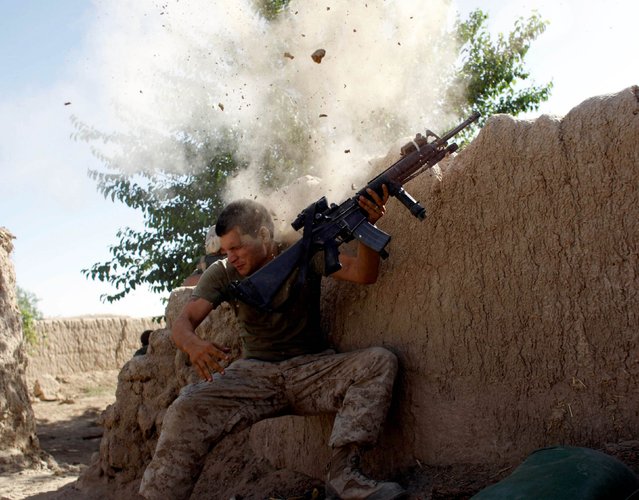
Sgt. William Olas Bee, a U.S. Marine from the 24th Marine Expeditionary Unit, has a close call after Taliban fighters opened fire near Garmser in Helmand Province of Afghanistan May in this 18, 2008 file photo. Goran Tomasevic: If I hadn't already been pointing the camera at the Marine when the bullet hit the wall, there is no way I would have been able to react quickly enough to take those pictures. Moments earlier I had been lazing around in Afghanistan's blistering desert heat, fending off waves of giant ants, wondering when I might get to test my new 24 mm lens. Gunshots rang out from beyond the perimeter of the compound the U.S. Marines were guarding in the district of Garmser, a Taliban stronghold in Helmand province, the biggest opium-producing region on the planet. I grabbed my boots and cameras and ran to look. The Marines had spotted some Taliban moving around the compound some 200 meters away. I took a quick look over the wall but couldn't see any Taliban. Then the gunfire began again. The Marines opened up with heavy machine guns. The Taliban answered back with single shots. I thought I'd better go back and put some trousers on. I also grabbed my flak jacket, helmet and some water. As soon as I got outside the firing erupted again. Sergeant William Bee was there with his M-16 rifle. He stood up and aimed his rifle over the wall. Suddenly it seemed to explode from an incoming round and Bee was down. I dropped my cameras and jumped towards him. I felt his head and neck expecting to find blood, but there was none. He was breathing, but unconscious. I picked up my cameras and shot a few more pictures, then went back to see how Bee was doing. When I found him, he was grinning from ear to ear. It was his lucky day. He hadn't been hit or seriously hurt. (Photo by Goran Tomasevic/Reuters)
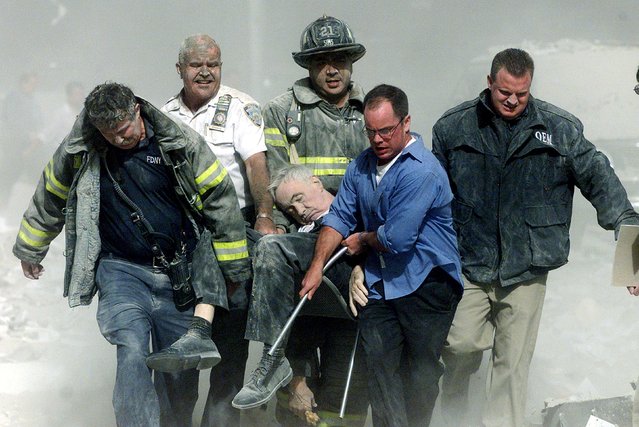
Rescue workers carry fatally injured New York City Fire Department Chaplain, Fether Mychal Judge, from one of the World Trade Center towers in New York, September 11, 2001. Shannon Stapleton: I will never forget the phone call from my bureau chief on the morning of September 11, 2001. “Shannon. A plane has hit the World Trade Center. Can you get down there as soon as possible?” I went to Times Square and looked at the jumbotron where people were starting to gather. Images of the first tower on fire were being shown. I made it by subway to Canal Street. Upon emerging from the station I saw people were running and screaming away from the World Trade Center site. It was at that point I knew I was about to cover probably one of the biggest stories of my young career right here in New York City, not somewhere far away that I had only seen in magazines. I gathered my gear, which at the time was one of the first digital cameras, the Kodak DCS 520, and my Contacx G20 film camera with B/W film, and ran towards the towers. Through the clouds of dust and shards of metal I noticed a group of men carrying a man slumped in a chair covered in dust. Time stood still. It struck me that among all this chaos these five men were carrying a man I knew was dead out of the rubble. I took several photos of them carrying him out as they yelled at me to get out of the way. I had no idea that the man they were struggling to get out of there was Father Mychal Judge, the Chaplain of the FDNY and the first reported death at the World Trade Center. I met the guys who carried him at the first 9/11 anniversary; they thanked me for taking that picture. They felt it was important that all know the story of Father Judge and that I had made that possible. (Photo by Shannon Stapleton/Reuters)
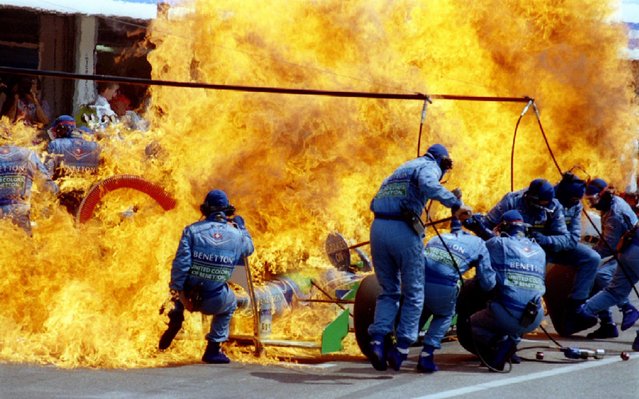
Petrol sprays on the Formula One racing car of Netherland's Jas Verstappen seconds before the car and the crew of Benetton Ford caught on fire during refueling at the German F-1 Grand Prix in Hockenheim in this July 31, 1994 file photo. Joachim Herrmann: I was covering the F1 race in Hockenheim, Germany and was one of the photographers on the pit wall during the race. Benetton's Jas Verstappen's team had problems while refueling his car: petrol was spraying all over the place before the car caught fire. The fire was extinguished quickly and the driver suffered minor injuries. It was the first time such an accident had occurred and I got all the right moments: the spraying petrol, the fire, the driver getting out of the car. I used a Canon with a 2.8 70/200 mm lens. The picture got wide, global play and it is one of the pictures I am known for. People still mention it in conversation, even though it was taken in 1994. It was challenging not to overshoot because on film you only have 36 frames. I was not sure how many frames I still had, so I had to shoot frame by frame and get all on that one roll of film. What's more, I couldn't return to the pit wall after leaving, which meant I had to find a way to ship my film to my editor – it worked perfectly with the help of an official. (Photo by Joachim Herrmann/Reuters)
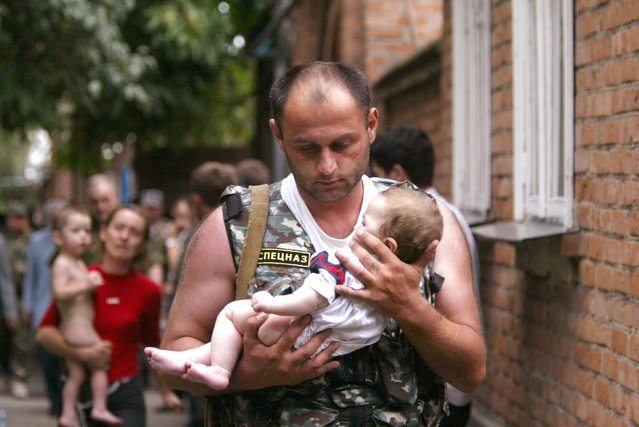
A Russian police officer carries a released baby from a school seized by heavily armed masked men and women in the town of Beslan in the province of North Ossetia near Chechnya, in this September 2, 2004 file photo. Viktor Korotayev: The Beslan school siege took place on September 1, 2004 during a festive ceremony to launch the new academic year at school No.1. Pro-Chechen gunmen seized the school and took 1,300 hostages on the first day. Some 331 people were killed, half of them children. On the second day of the siege, the captors were convinced to free several women with babies, so when a fighter of a special task unit was seen leaving the building with a child in his hands, there was hope that children could be saved. I think that was why this photo was published on the front pages of numerous publications all over the world. Throughout my career I've covered many difficult stories such as military conflicts in different countries, disasters, hostage situations. The Belsan tragedy remains the biggest psychological trauma I have experienced. (Photo by Viktor Korotayev/Reuters)
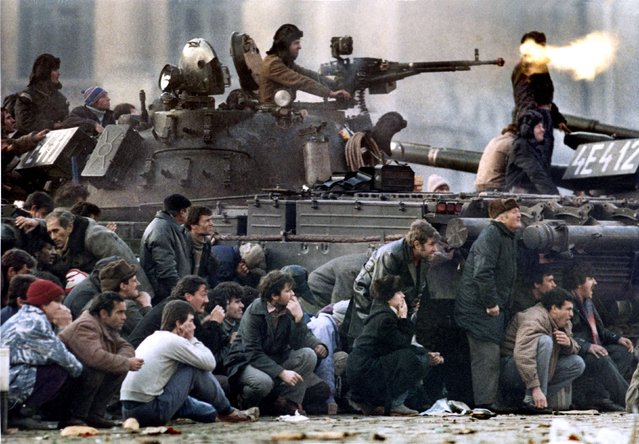
Bucharest's residents protect themselves from the crossfire during clashes in the Republican square in Bucharest December in this 23, 1989 file photo. Charles Platiau: On December 22 1989, my mind was still full of memories of covering the fall of the Berlin Wall. I was ready to celebrate Christmas with my family, but the Romanian communist dictator Nicolae Ceausescu changed my plans. My boss and I were watching Ceausescu leave Bucharest by helicopter live on TV. I rushed to the airport and was lucky to board a flight chartered by the Medecins du Monde humanitarian organisation. We landed at in Bulgaria and took a taxi to the Romanian border. Luckily the border was not closed and I hitch-hiked a ride to the capital on a truck. At noon I simply took the metro to arrive in downtown Bucharest in the middle of heavy gunfire. No helmet, no bullet proof jacket, only the enthusiasm of youth and the joy of witnessing a historical event: a revolution. With my 300 mm 2.8 and an extender, I shot residents protecting themselves in the crossfire between an army tank and pro-Ceausescu troops during clashes in Republican square. No time for more pictures, just enough time to process and send a lone color print to reach Sunday newspaper deadlines.There were only two phone lines at the hotel, and scores of reporters arriving to file their stories. I kept the phone line open and did not hang up for 10 days in order to transmit pictures and stories. The picture made the front page of most international papers. It was not the best picture of the revolution but one of the first color pictures to hit the media market. It reminds me how hard it was to get around with cases of heavy equipment (80 kg of gear including an enlarger, photo paper, a transmitter, a typewriter). (Photo by Charles Platiau/Reuters)
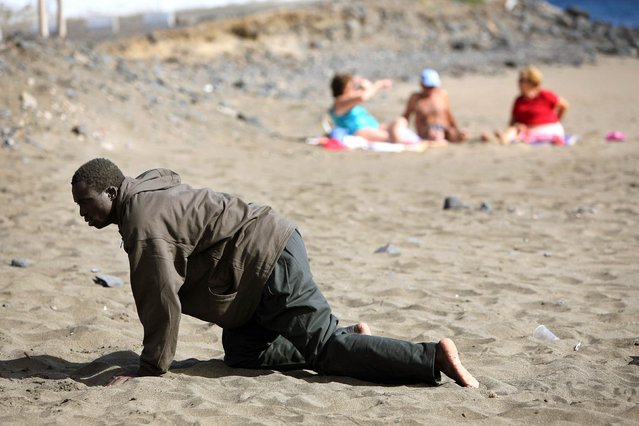
A would-be immigrant crawls on the beach after his arrival on a makeshift boat on the Gran Tarajal beach in Spain's Canary Island of Fuerteventura in this May 5, 2006 file photo. Juan Medina: I heard about a makeshift boat carrying migrants from Africa was on its way to the beach at Gran Tarajal, south of the island of Fuerteventura so I rushed there. When I arrived, the migrants, who risk their lives trying to reach European soil in flimsy boats, were being treated by members of the Spanish Red Cross who were providing them with clothes and water. They were exhausted from their perilous journey. The strength of this image is that it shows the contrasts in our society: on one side of the photograph you have people who seem to be enjoying the sun on the beach and on the other a man crawling through the sand after risking his life at sea. It was challenging to show as clearly as possible the inhumane conditions African migrants must endure in order to reach Europe. But there are also many things that this image doesn't show but that are very important in explaining why these people risk so much. For example, we don't get to see the suffering and solitude they endure after leaving their families behind. I believe images that tell the stories of the migrants should affect everyone. Nobody should be immune to the plight of these people. (Photo by Juan Medina/Reuters)
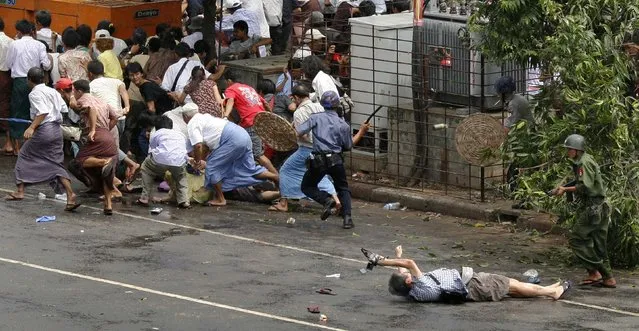
Kenji Nagai of APF lies dying after police and military officials fired on him in Yangon in this September 27, 2007 file photo. Adrees Latif: I was covering the “Saffron Revolution” in Myanmar where rising fuel prices ignited protests. After weeks of protests mostly led by monks, security forces raided monasteries and arrested monks in an effort to quell the demonstrations. On September 27, tens of thousands of protesters took to the center of Yangon, near the Sule Pagoda. Armed military forces arrived to the scene and dispersed the crowd with smoke bombs and machine guns. Seconds after the military opened fire on the crowd, I saw a man falling to the ground and turned my camera to his direction to photograph. I would later learn it was Japanese video journalist Kenji Nagai working amidst the protesters. On this particular morning, the military had set up roadblocks and there was an eerie silence in the air. The streets were empty and I found refuge in a monastery for novice monks. Before midday, I made my way by foot to the city center. As I arrived, some dozens of protesters were shouting slogans. With every passing minute, their numbers multiplied. I took position on a pedestrian bridge. From atop I could see dozens of military vehicles approaching. The soldiers opened fire soon after their arrival. While photographing, I took refuge amidst a bridge full of protesters lying flat to avoid being shot. Soon after I felt a strong urge to preserve the images I had made and found a way off the bridge. Over the years, I read of previous crackdowns by the junta on protesters but never saw photographic proof from reliable or unbiased sources. This image provided a rare public glimpse of the raw brutality of one of the world's most secretive regimes. (Photo by Adrees Latif/Reuters)
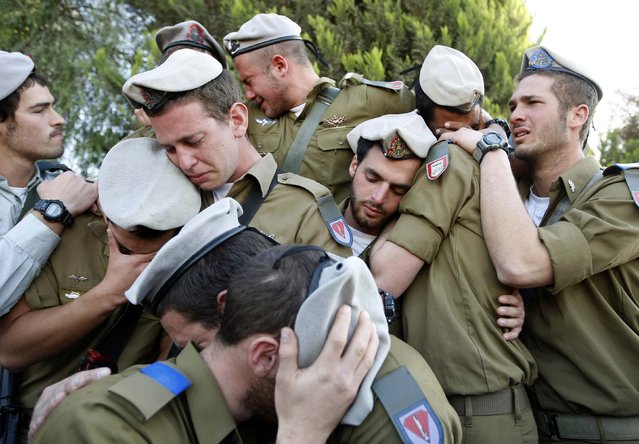
Israeli soldiers mourn during the funeral of their comrade Alex Mashavisky at a cemetery in Beersheba in this January 7, 2009 file photo. Eric Gaillard: I was in Israel to help out the Reuters Jerusalem office during the Israeli offensive in the Gaza Strip in January 2009. They asked to go to Beersheba to cover the funeral of an Israeli soldier, Alex Mashavisky, who was killed in an operation in Gaza. There was so much emotion at this funeral to begin with, and within minutes a rocket exploded near the cemetery and everybody had to fall to the ground. It was a really surreal and emotionally charged moment. The place was so narrow and there were so many photographers. The challenge was to hold a spot where I would be able to see the ceremony. I shot this picture with a Canon Mark III and a zoom 16-35 lens. A 14 mm would have been much better because the place was very narrow and I was really close from the soldiers. I sent the picture from the cemetery with a MIFI which was at this time a novelty. (Photo by Eric Gaillard/Reuters)
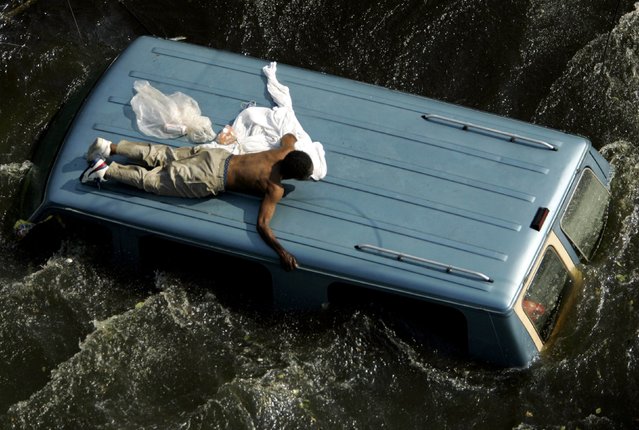
A man clings to the top of a vehicle before being rescued by the U.S. Coast Guard from the flooded streets of New Orleans, in the aftermath of Hurricane Katrina, in Louisiana in this September 4, 2005 file photo. Robert Galbraith: I arrived in New Orleans three days after the hurricane struck, and was flown via a Coast Guard four-seat airplane from Alexander, Louisiana to the U.S. Coast Guard Station in New Orleans. Unable to see anything other than the death and destruction visible through the open door, we began circling and descending and suddenly I saw a man, dressed in khakis, tennis shoes and shirtless, looking desperately toward us from the top of the van in rising flood water. With the helicopter rotating closer, he rolled to his side and clung to the top of the vehicle. Moments later a rescue swimmer loaded him into a basket and he was raised into the helicopter. We then flew to Louis Armstrong Airport, where he was placed on a stretcher and provided medical attention. It was odd to see someone, six days after the hurricane struck, sitting on top of the van, a tall can of Budweiser beer and a broom nearby, visible in other pictures that were filed. When he entered the helicopter, he asked of my camera “What's that?”. The story had a major impact on me personally. I've covered many disasters – massive fires, floods, riots, earthquakes – but Hurricane Katrina was beyond category in what I had previously experienced. When I returned home I was in the process of moving, and didn't watch television or connect my telephone for a couple of months. (Photo by Robert Galbraith/Reuters)
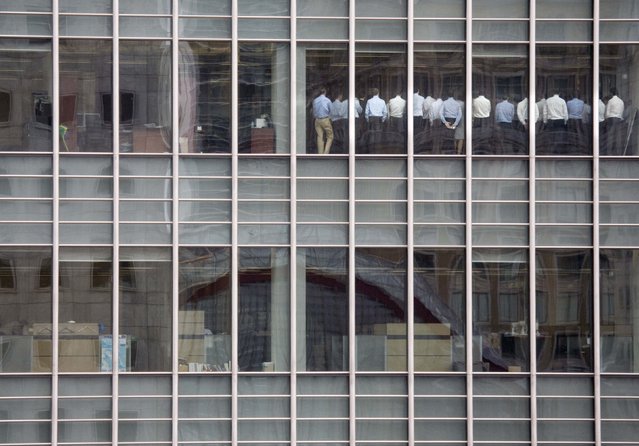
Staff members stand in a meeting room at Lehman Brothers offices in the financial district of Canary Wharf in London in this September 11, 2008 file photo. Kevin Coombs: This is a very simple story. This photo was shot from the fourth floor newsroom at our offices in Canary Wharf, the heart of London's financial district. I was working on the pictures desk when I noticed three or four journalists looking out of the window. This is a busy newsroom and people don't hang around staring out the window so I immediately grabbed my camera and ran across to see what was happening and spotted the Lehman employees. I knew Lehman was struggling and I knew that was the Lehman Brothers building. As I was shooting the picture I was really thinking about how best to stop the reflections as I was shooting through thick glass. The people lining up is what struck me first but I did not realise the significance of it until I walked back over to the desk and checked our systems which showed the Lehman share price dipping. It became obvious that this was a crisis meeting and at that point I knew this was an important picture. The picture has been used over and over to illustrate the beginning of the global financial crash. For me to shoot one of my most used pictures from our newsroom window is quite bizarre, but it proves you only see good pictures when you look around and have your camera ready at all times. (Photo by Kevin Coombs/Reuters)
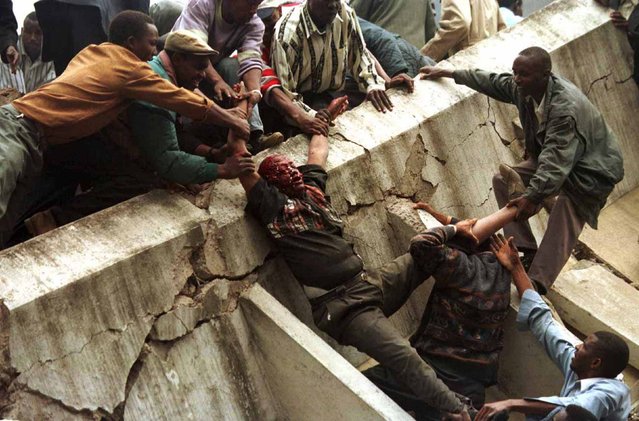
A body is removed from the wreckage after a bomb went off in Nairobi, August 7, 1998. The bomb, which killed more than 250 people and injured 5,000, was aimed at the U.S. embassy. It destroyed a neighboring building and badly damaged the embassy. (Photo by George Mulala/Reuters)
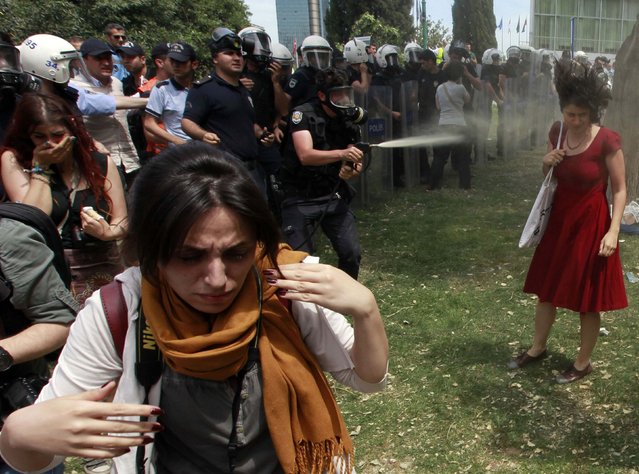
A Turkish riot policeman uses tear gas as people protest against the destruction of trees in a park brought about by a pedestrian project, in Taksim Square in central Istanbul in this May 28, 2013 file photo. Osman Orsal: I was covering protests in Istanbul which began as a demonstration against government plans to demolish a small park in central Taksim square but evolved into one the biggest anti-government protests in over a decade. I was standing between the protesters and the police as the police began firing tear gas at a close distance. The crowd started to run in different directions, causing chaos. I started shooting and the lady in the red dress was standing right at the front. The picture depicts the somewhat unequal struggle between the police and the protesters by showing a police officer firing tear gas from such a close distance towards a woman who had little room to defend herself. How popular this image became has actually made me proud. It was described as “iconic” by politicians, artists, writers and ordinary citizens. I have won around a dozen awards and I was and still am humbled by people's appreciation of my work over this picture. (Photo by Osman Orsal/Reuters)
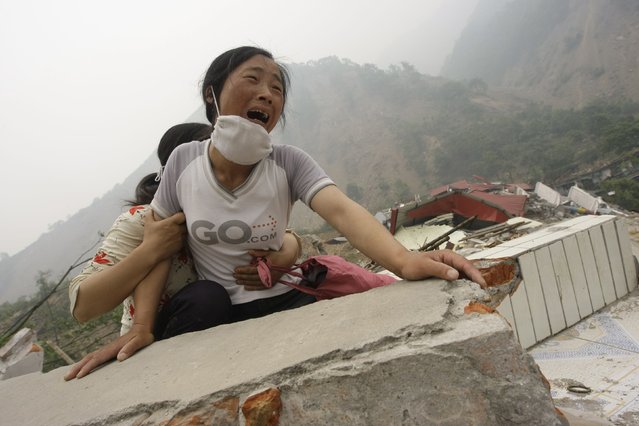
A woman cries as she cannot find her 4-year-old daughter and husband on the top of the ruins of a destroyed school in earthquake-hit Beichuan county, Sichuan province in this May 17, 2008 file photo. Jason Lee: It was the fifth day since the deadly Sichuan Earthquake shook southwestern China. People were still looking for survivors in the ruins of Beichuan county, one of the worst-hit areas. A landslide triggered by the earthquake had buried a kindergarten and the woman pictured, a mother of a four-year-old girl who was buried under the ruins, kept crying out her daughter's name and kept blaming herself, saying it was all her fault. I was shooting military troops search for surviving children in the ruins when her desperate crying caught my attention. I tried to be quiet and crouched in front of her to shoot for about one minute and after a while checked with her relatives for more details. On the morning of the earthquake, her daughter told her she wasn't feeling too well and didn't want to go to kindergarten. The mother was a bit upset, thinking her daughter might be lying to get away from school. The mother, whose husband was also killed in the earthquake, kept saying that she was responsible for her daughter's death, as if she might still be alive if she had allowed her to stay at home. The sadness in the woman's crying and the story behind it left a deep mark on me, reminding me of the cruelty and ruthlessness in disasters. Covering this story affected me deeply. I was 33 at the time, in my best shape physically, and all I thought about was my career. But after the coverage, I felt it was time to start a family and have a warm home to return to. (Photo by Jason Lee/Reuters)
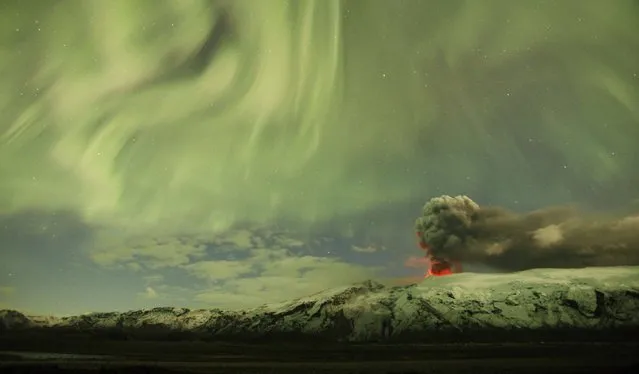
The Northern Lights are seen above the ash plume of Iceland's Eyjafjallajokull volcano in the evening in this April 22, 2010 file photo. Lucas Jackson: The ash cloud brought the greatest disruption to European air travel since World War Two, and the only way to get to Iceland was to fly from North America. I travelled overnight, arriving at Keflavik airport at 6:30 a.m. on April 17. In a rented car I drove east towards the ash plume on the horizon. The scale of the assignment had begun to sink in, and I realized it would require careful thinking, rather than instant reaction. For images of the eruption itself I was dependent on the weather. The plume would be invisible if it was overcast, and if the wind died the ash would turn to a haze. For a photograph of lightning flashing inside the ash cloud I had to wait for several hours on a washed-out road, and physically hold my shutter open for more than two minutes. To show vehicle-size chunks of lava exploding out of the volcano I had to drive through eight different rivers and up a mountain to angle a 300 mm lens at the crater. On my last evening I was blessed with a show from the Aurora Borealis (Northern Lights) while lava illuminated the ash plume from below. I will always remember this assignment fondly. I feel lucky to have been able to document the eruption so others could share in the amazement – watching Mother Nature negate centuries of human technology and progress with one of the most beautiful sights on earth. (Photo by Lucas Jackson/Reuters)
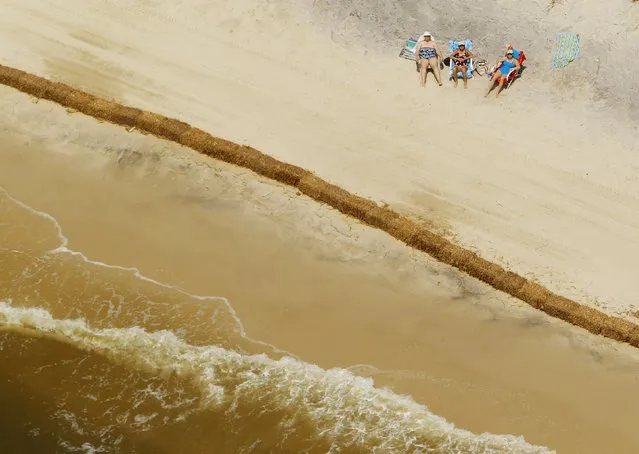
Beach goers sunbathe behind a wall of hay bales, used to absorb any oil that might come ashore, on Dauphin Island, Alabama in this May 11, 2010 file photo. Brian Snyder: I was in Alabama and Mississippi covering the BP oil spill and took this image while in a helicopter with the Alabama Army National Guard. We had been flying for a while, surveying the protective booms installed around the barrier islands in the Gulf of Mexico off the Mississippi coast, and were making our way back to the base. It's always challenging photographing from a helicopter – apart from making sure the images are sharp despite the helicopter moving and bouncing around, images pass by fairly quickly so you have to be fast. To me, this image shows an important aspect of the oil spill story: the impact on the daily lives of the residents and the significant, negative impact on tourism which is an important part of the region's economy. It also shows some of the effective and extremely low-tech ways to protect beaches from oil washing ashore – in this case simple hay bales. It was a challenge, when shooting this story, to have images that put the oil spill in context, and I think this image does that. (Photo by Brian Snyder/Reuters)
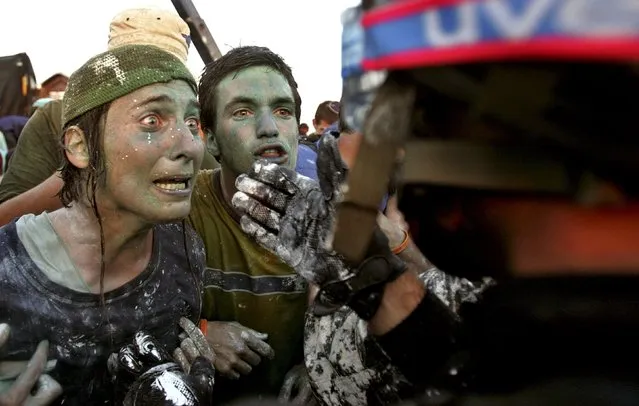
Opponents of Israel's disengagement plan from Gaza scream as they speak with a special evacuation policeman after the forces took over the roof top of the synagogue in the Jewish Gaza Strip settlement of Kfar Darom in Gush Katif settlements bloc in this August 18, 2005 file photo. Nir Elias: One of the most hardcore spots of “resistance” against the forces coming to evacuate the settlers was this settlement called Kfar Darom. The settlers and many of their supporters were barricaded on the roof of the synagogue and the picture was taken after special forces came to take them down in containers lifted by cranes. Before it happened I spent a week getting to know the people so that I could get their permission to go with them onto the roof. I think the power of this picture is that this situation is quite bizarre as on one hand it shows the boiling point of something that had been building up for months and was supposed to explode but on the other there was no violence at all; just some strange moments because at the end of the day there was very much of a feeling of brotherhood on both sides. It was quite a challenge to get close enough to the people for them to let me go up to the roof with them. I spent a week in a tent on the outskirts of the settlement winning their trust. The forces were trying to break up the people on the roof by shooting coloured water cannons at them, hence the colours on their faces. The only way the people on the roof were taken down was one by one and hand in hand. (Photo by Nir Elias/Reuters)
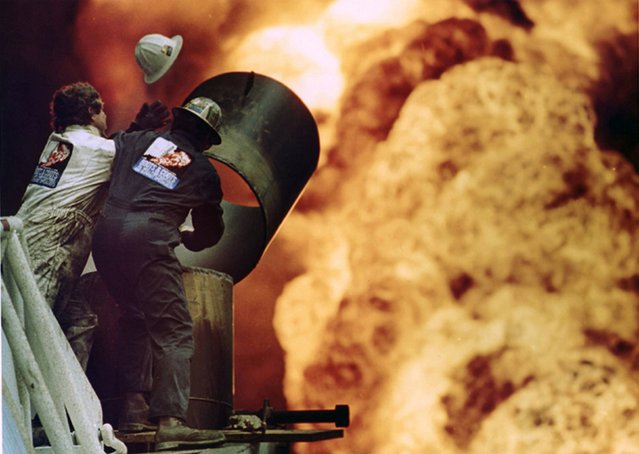
Oil fire fighters from Boots and Coots try to put out an oil well fire in Al-Ahmadi where retreating Saddam Hussein forces had set fire to the oil wells, in this March 30, 1991 file photo. Russell Boyce: The workers were trying to contain the flames with a shield and tube when a blast of heat blew off the helmet of one of the workers. The flames seem to dwarf the workers, who look almost helpless as they struggle against what looks like the very flames of hell. To get access to the fires we had to drive through a lake of oil created from the wells. Once we got there, the heat was so intense that you we could not get close. A slight change of wind and we'd be covered in choking fumes. It was 1991, the pre-digital age, and I was using Nikon F3P to transmit the picture. I had to return to my hotel room, process film, make a colour print, stick a paper-typed caption on the print and use a drum transmitter to send the picture. Initially we transmitted pictures on our satellite phone – which was as big as a large trunk suitcase that two people had to carry as it was so heavy. We had a generator running in my room as there was no power in Kuwait City so my room always smelt of fumes from the generator, photographic chemicals and fumes from the oil fires. There was no water, except for about an hour a day, so processing film was difficult: I would fill the bath with water when it was on so that I always had a way to process film. Eventually, the telephone lines were reconnected so it might have been transmitted over them. The picture took 21 minutes to transmit, each separation, magenta, cyan and yellow, taking seven minutes. (Photo by Russell Boyce/Reuters)
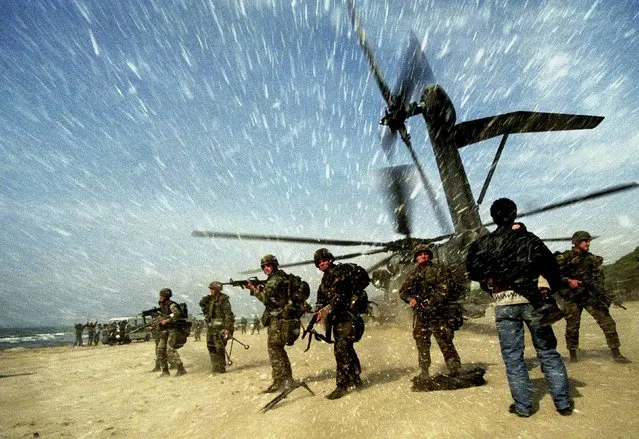
An Albanian man carries a child to a US Marine CH53 Super Stallion helicopter as it lands at Golame beach near the port of Durres, in this March 16, 1997 file picture. Yannis Behrakis: I was covering the unrest in Albania following the pyramid scheme failures. Albanian civilians had lost $1.2 billion and Albania descended into civil disorder and violence. The government was toppled and 2,000 people were killed. My late colleague Kurt Schork and I were the only members of the press staying in a hotel where the armed owner protected us from bandits who would rob every journalist who dared to come alone to cover the story. The owner insisted on placing Kalashnikovs and hand grenades in the closets of our rooms “to protect ourselves if needed”, as he said. On March 16 we drove to Golame beach where two U.S. helicopters had landed, kicking off a blizzard of sand as hundreds of desperate Albanians gathered in the area, hoping to get a lift out of the country. Blinded by the sand I shot a few pictures when an Albanian man holding his child ran towards the helicopter. About a dozen U.S. Marines jumped off the Super Stallion and pointed their M-16 assault rifles at the Albanians. The man with the child was begging the soldiers to let him in onboard. The Marines were clearly surprised by the crowd and asked me what was going on, and if I saw any foreigners trying to leave. I explained that these people were just desperate and wanted to leave Albania, and that they thought the helicopters were there to take them to safety. The situation was getting out of control and a few warning shots were fired and people were beaten back with rifle butts. The fact that we decided to take the risk and stay in Durres paid off. Papers all over the world ran these pictures on their front pages. (Photo by Yannis Behrakis/Reuters)
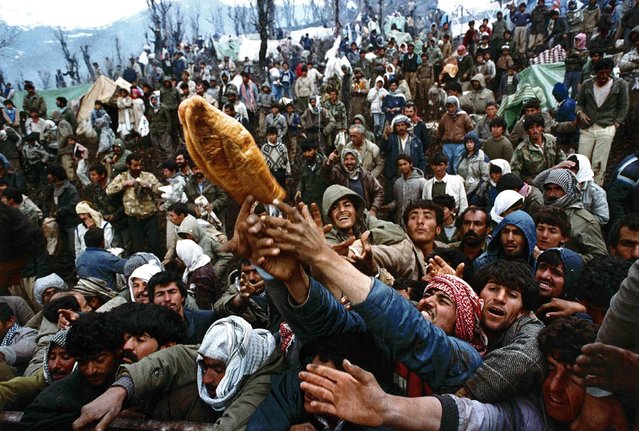
Frantic Kurdish refugees struggle for a loaf of bread during a humanitarian aid distribution at the Iraqi-Turkish border in this April 5, 1992 file photo. Yannis Behrakis: At the end of the first Iraq war about 1.5 million Kurds were fleeing in panic trying to escape from forces loyal to Saddam Hussein. About 600,000 of them fled to Turkey but half of them were stranded in the mountains at the Iraqi-Turkish border. I hitch-hiked a ride on a tractor pulling a cart full of bread to feed the stranded Kurdish refugees atop the snow capped mountains at the border. As the tractor made its way slowly through the dangerous dirt road, it was attacked by hundreds of hungry refugees who fought against each other and the aid workers. The men I was riding with tried in vain to stop the refugees from taking the bread but the refugees were absolutely desperate and the aid workers gave up. Getting up the mountain to cover the story was extremely difficult. I remember leaving the hotel every morning at 4 am in order to reach the bottom of the mountain two-and-a-half hours later. Then I hitchhiked my way on either a tractor carrying bread or on a snow-removal vehicle clearing the road. Once, my hands were so cold they stuck to the snow-removing vehicle. Pictures like this put pressure on the Turkish government to allow proper humanitarian aid to reach the refugees. It also alerted the international community about the tragic events in this part of the world and received very good play in what was the biggest story in the world at the time. It was the first time I was covering a humanitarian crisis and I was stunned with the cruelty some people demonstrated towards unprotected humans. I also understood that photojournalism is a very strong medium that can make a difference and help people in need. (Photo by Yannis Behrakis/Reuters)
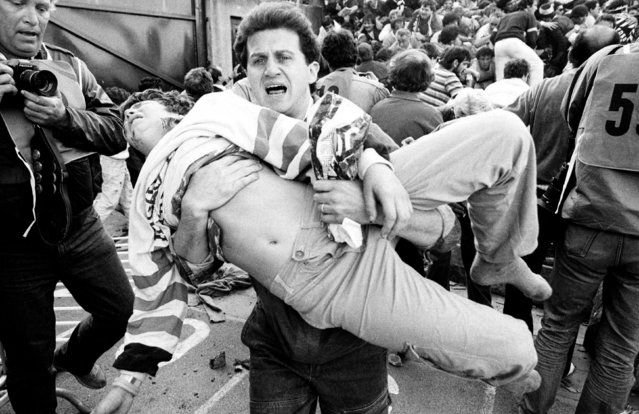
An injured soccer fan is carried to safety by a friend after a wall collapsed during violence between fans before the European Cup final between Juventus and Liverpool at the Heysel stadium in Brussels, May 29, 1985. 39 people died, and a further 600 were injured. (Photo by Nick Didlick/Reuters)
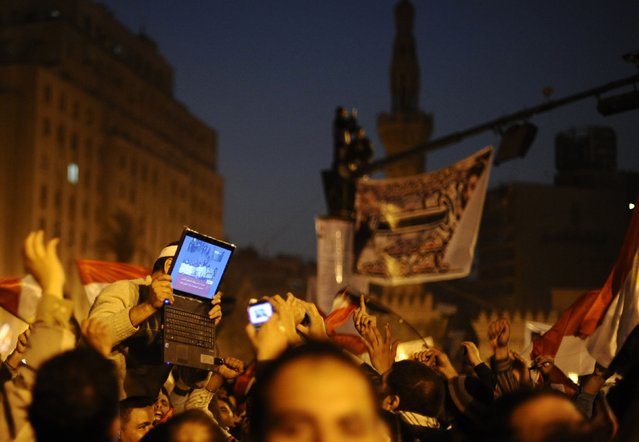
An opposition supporter holds up a laptop showing images of celebrations in Cairo's Tahrir Square, after Egypt's President Hosni Mubarak resigned in this February 11, 2011 file photo. Dylan Martinez: I was lucky enough to be sent to Egypt in 2011 for what became known as the Facebook Revolution. Thousands of Egyptians had taken to the streets to demand the end of President Hosni Mubarak's 30-year rule. When I arrived in Egypt, customs officials at the airport confiscated almost all of my kit but after over four hours of discussions, one customs official took pity on me. He let me keep a Nikon D700 and a 50mm lens. There are some days that stay with you forever. The day I took this picture was one of those. After two weeks of almost no sleep, one arrest and even a beating by opponents of the revolution, I was happy to be in Tahrir Square the moment the news broke that Mubarak had stepped down. The problem for me was that the news broke at after dusk. As the euphoria rolled around the square, some jumped in jubilation while others shed tears of joy. The scene was incredible but I was frustrated: It was so dark that I could not capture much of the action. I was seeing history but unable to get the picture. Then I spotted this man holding a laptop and chanting “Facebook! Facebook!” like a football supporter. Nice moment. I was just relieved he did it in a pool of light. (Photo by Dylan Martinez/Reuters)
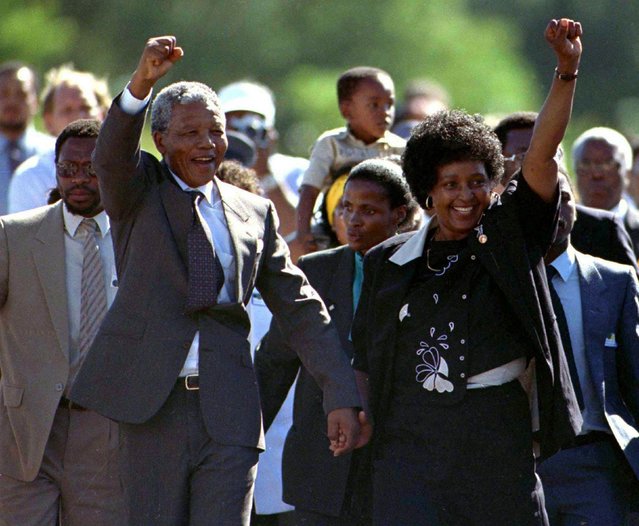
Nelson Mandela, accompanied by his wife Winnie, walks out of the Victor Verster prison near Cape Town after spending 27 years in apartheid jails in this February 11, 1990 file photo. (Photo by Ulli Michel/Reuters)
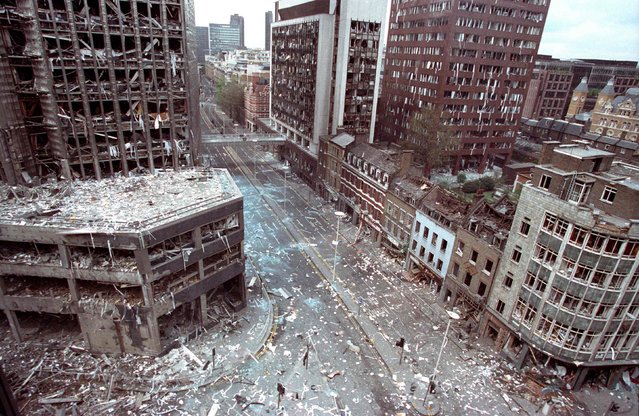
The bomb damaged area of the City of London is seen in this April 24, 1993 file photo after two blasts ripped through the buildings in the area. Dozens of people were injured in the blast caused by IRA bombs. (Photo by Andre Camara/Reuters)
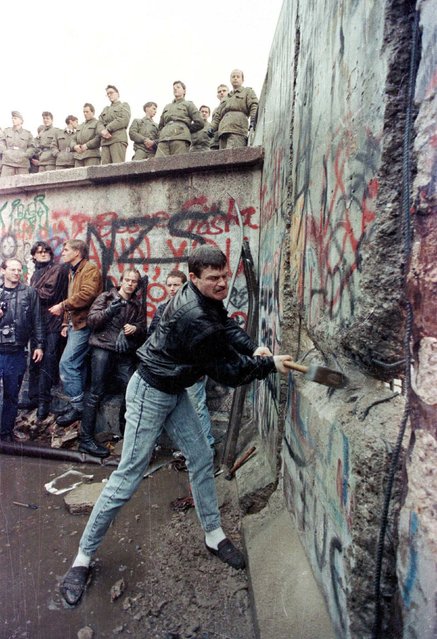
A demonstrator pounds away at the Berlin Wall as East Berlin border guards look on from above the Brandenburg Gate in Berlin in this November 11, 1989 file photo. (Photo by David Brauchli/Reuters)
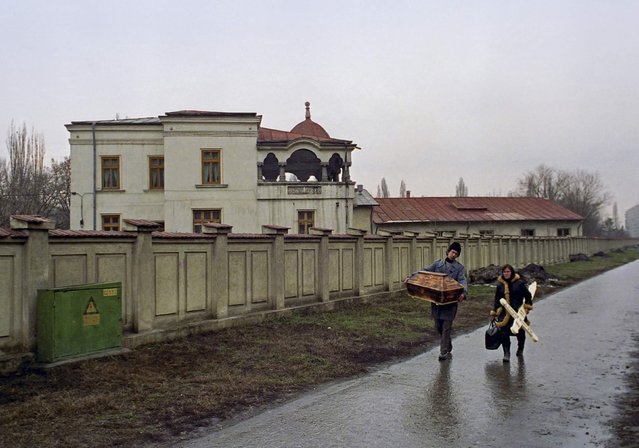
Romanian parents carry a small casket and cross as they arrive at a Bucharest hospital to collect the body of their dead baby who died of AIDS in this February 6, 1990 file photo. Radu Sigheti: I found out that there is a ward at a hospital in Bucharest where children with HIV positive were hospitalised. I thought this is a story worth pursuing, at the time I had no idea what AIDS meant and I wanted to find out, thinking it would make a good story. I went there and took pictures of the children, aged between one to five years old but many looking like they were over 100; frail and helpless in their beds. One had died a day before. The smell of chloride was punching. At the time they used to spread it around that ward thinking it would keep it sterilised. That smell and the sight of those children, there were about 20-30 hospitalised, made me anxious and after a while I decided to leave as I could not stand it anymore. As I left with a friend we found his car, parked outside the hospital, with a flat tyre. He started working to replace it then at one moment I heard steps behind me. When I turned I saw this picture and I knew why they were there, for the child who died of AIDS a day before. I grabbed the camera and I took one shot. In the moment the couple heard my shooter noise they raised their eyes and looked straight at me. I took one more frame and I put the camera down. The look in their eyes said everything about their sorrow. I could not take any more pictures; I just followed them with my eyes as they slowly entered the hospital yard. (Photo by Radu Sigheti/Reuters)
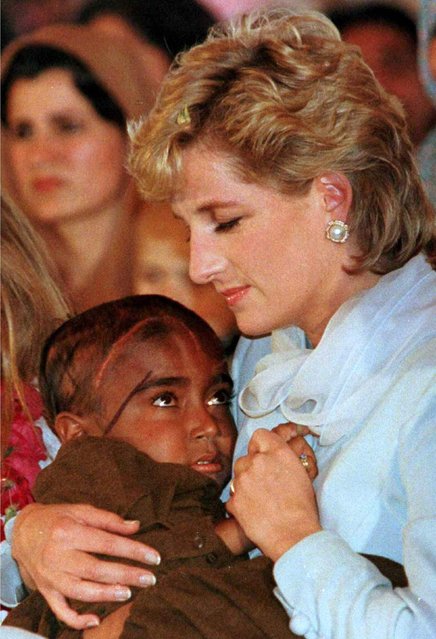
Diana Princess of Wales cradles a young child stricken with cancer during a show at the Shaukat Khanum Memorial Cancer Hospital in Lahore in this February 22, 1997 file photo. (Photo by John Pryke/Reuters)
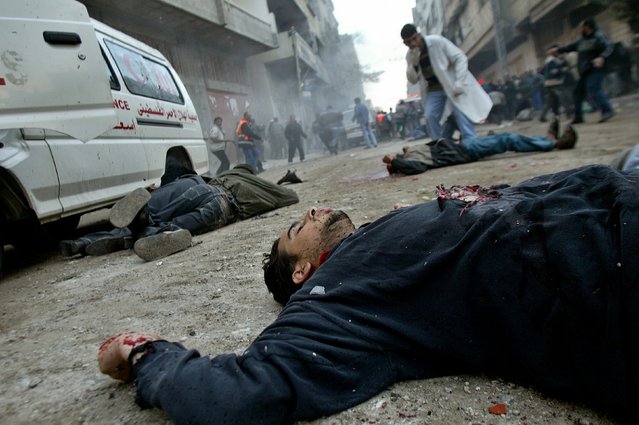
Unidentified bodies lie on a street in the Jabalya refugee camp in northern Gaza Strip, March 6, 2003. Ahmed Jadallah: I was with a Reuters multimedia team to cover incursion a big Israeli incursion to the Gaza Strip. The Israeli tanks had started to withdraw when there was a big fire in one of the buildings due to an air strike. As I was shooting pictures at the site amongst a crowd of people a tank shell hit us. At least 14 people were dead and many wounded, including me. I had been hit with shrapnel that ripped apart my lower leg. I collapsed on the floor. At that particular moment I felt like dying and sinking into a big hole in the ground, motionless. I didn't stop thinking of my family and I could see people next to me fighting to survive, while some were already dead. It all happened in a matter of seconds. Somehow, in the middle of all this, I took three pictures without looking directly through my camera. Don't ask me how I did that! Two frames were out of focus and one in focus. This picture won first prize in the World Press Photo spot news category. (Photo by Ahmed Jadallah/Reuters)
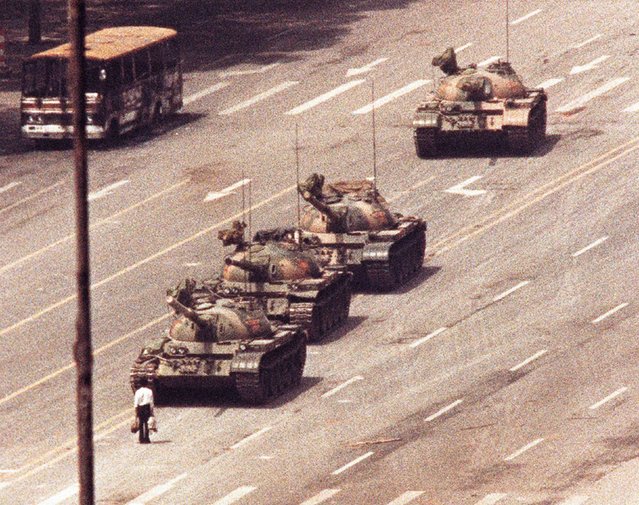
A man stands in front of a convoy of tanks in the Avenue of Eternal Peace in Tiananmen Square in Beijing in this June 5, 1989 file photo. (Photo by Arthur Tsang/Reuters)
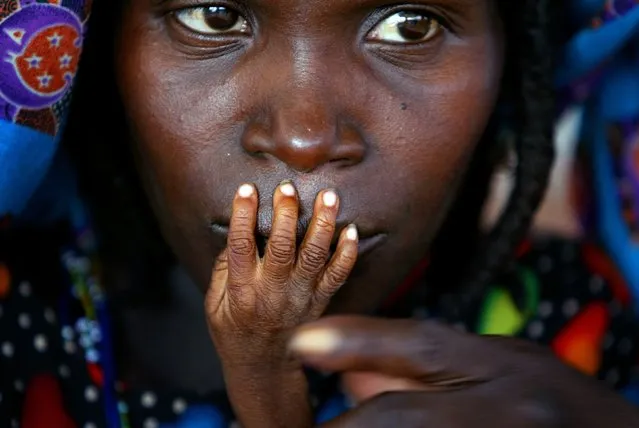
The fingers of malnourished one-year-old Alassa Galisou are pressed against the lips of his mother Fatou Ousseini at an emergency feeding clinic in the town of Tahoua in northwestern Niger, in this August 1, 2005 file photo. One of Niger's worst droughts in living memory destroyed much of October 2005's crop, leaving an estimated 3.6 million people short of food, including tens of thousands of starving children who could die without urgent assistance. (Photo by Finbarr O'Reilly/Reuters)
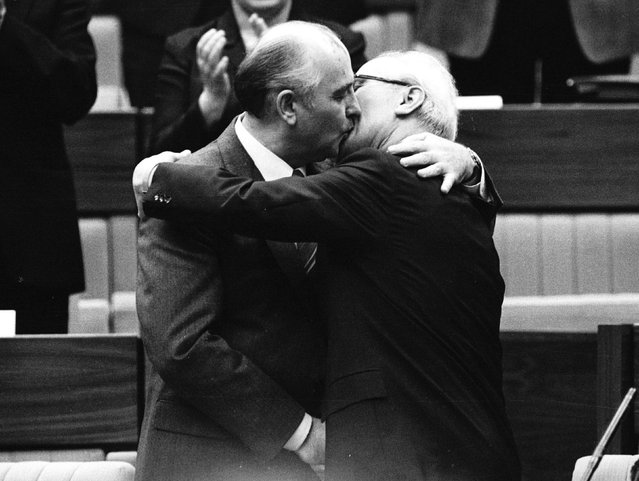
Soviet Leader Mikhail Gorbachev (L) congratulates East German Leader Erich Honecker with a kiss after Honecker's re-election as General Secretary of the Communist Party Congress in East Berlin in this April 21, 1986 file photo. (Photo by Reuters/Stringer)
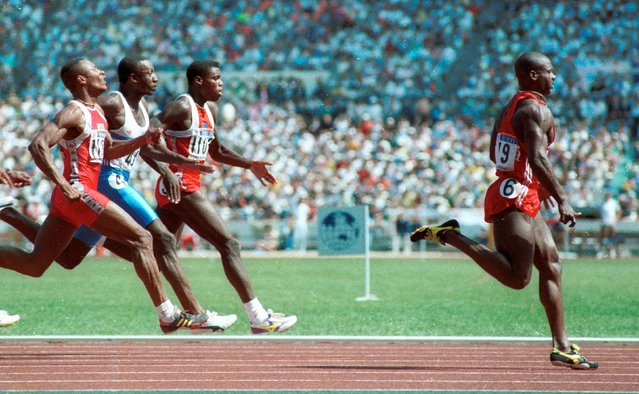
Sprinter Ben Johnson wins the gold medal in the 100m sprint at the Seoul Olympics in this September 24, 1988 file photo. Behind him are (L to R) Calvin Smith, Linford Christie and Carl Lewis. Johnson later lost the medal when he tested positive for steroids. (Photo by Gary Hershorn/Reuters)

Palestinians try to run away from Israeli soldiers firing teargas during Palestinian-Israeli clashes in the southern Gaza Strip town of Khan Younis in this October 20, 2000 file photo. (Photo by Reinhard Krause/Reuters)
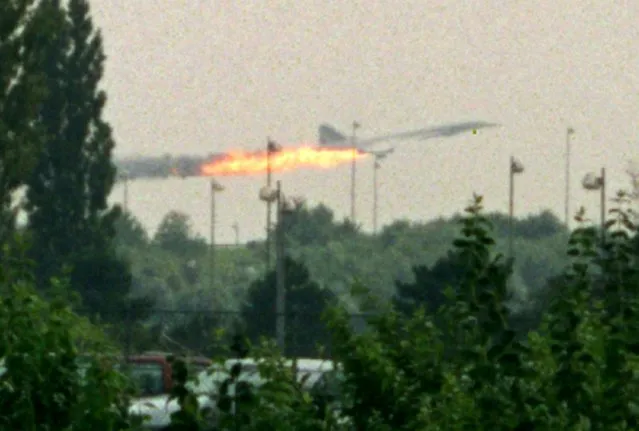
Flames come out of the Air France Concorde seconds before it crashed in Gonesse near Paris Roissy airport in this July 25, 2000 file photo. All one hundred passengers and nine crew members on board the flight died. On the ground, four people were killed and one critically injured. (Photo by Andras Kisgergely/Reuters)
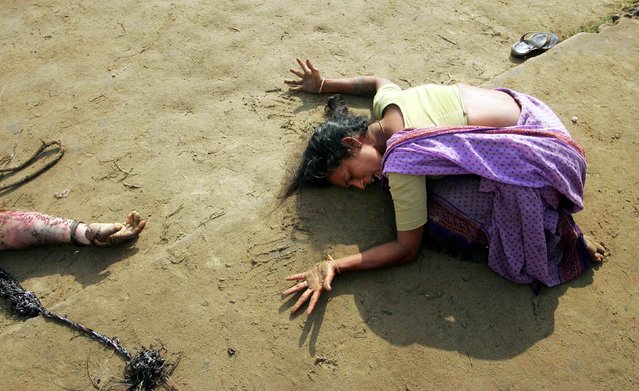
An Indian woman mourns the death of her relative (L) who was killed in the tsunami in Cuddalore, some 180 km (112 miles) south of the southern Indian city of Madras in this December 28, 2004 file photo. The South East Asia Tsunami killed 230,000 people in 14 countries. It was one of the deadliest natural disasters in recorded history. Indonesia was the hardest-hit country, followed by Sri Lanka, India, and Thailand. (Photo by Arko Datta/Reuters)
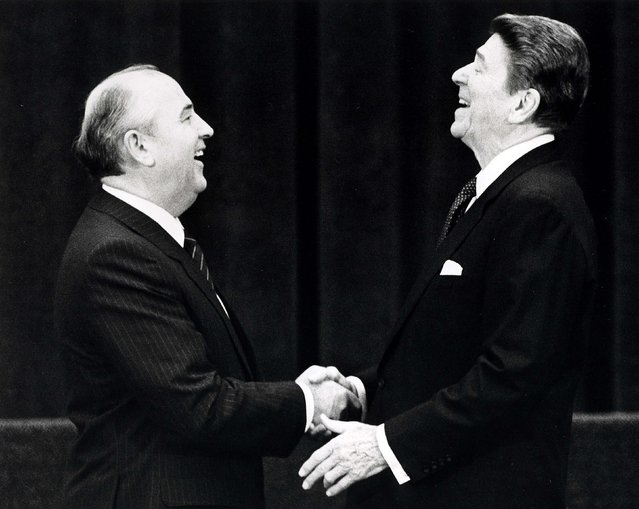
U.S. President Ronald Reagan (R) shakes hands at his first meeting with Soviet leader Mikhail Gorbachev to sign an arms treaty in Geneva, in this November 19, 1985 file photo. The two leaders met for the first time to hold talks on international diplomatic relations and the arms race. (Photo by Reuters/Stringer)
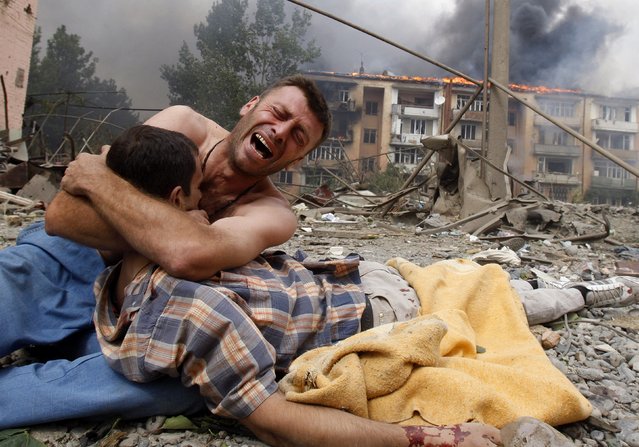
A Georgian man cries as he holds the body of his relative after a bombardment in Gori, Georgia, August 9, 2008. Gleb Garanich: I was about to head off on a fishing holiday when my boss called proposing that I head off to cover the unfolding conflict between Georgia and Russia. In a matter of hours, I was on my way to the airport and around midnight I landed in Tbilisi. Early the next day, I went off to the Georgian town of Gori together with colleagues from Reuters TV. We took some pictures then decided to head out of town towards Tskhinvali, capital of the separatist region of South Ossetia. But within ten minutes our Tbilisi photographer Dato – using a walkie-talkie I had brought to make up for poor telephone communications – was shouting down the line that a bombardment was under way on the outskirts of Gori. Five minutes later, a series of bombs began exploding in another district on the road heading back to Tbilisi. I informed Dato of events on the walkie-talkie. Within minutes, Dato arrived at the spot and reported considerable destruction and victims and within five minutes we, too, were at the site. In the street, Georgian soldiers were taking the wounded out of apartment buildings or carrying away bodies covered in blankets. I then saw a man in a neighbouring courtyard weeping over the body of his brother. Georgian servicemen tried to help him and cover the corpse but he did not let them, hurled his mobile telephone at them and allowed no one to approach the body. He tore off his t-shirt and tried to cover his brother's body with it before sitting on the ground and embracing his brother's corpse. Ten minutes later, he was calmed down by neighbours and soldiers took away the body. (Photo by Gleb Garanich/Reuters)
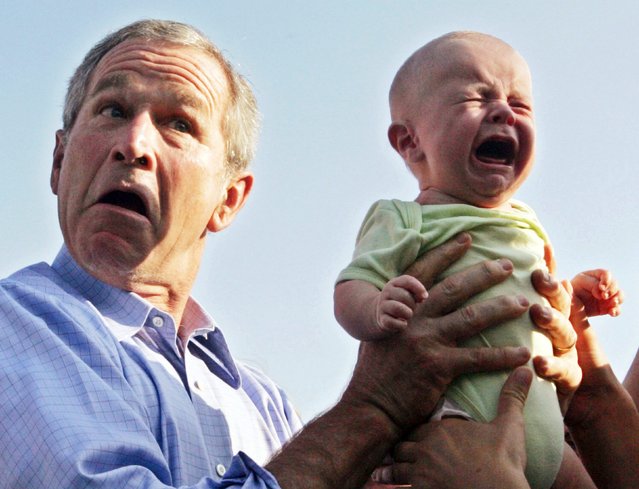
U.S. President George W. Bush hands back a crying baby that was handed to him from the crowd as he arrived for an outdoor dinner with German Chancellor Angela Merkel in Trinwillershagen, Germany in this July 13, 2006 file photo. (Photo by Jim Bourg/Reuters)
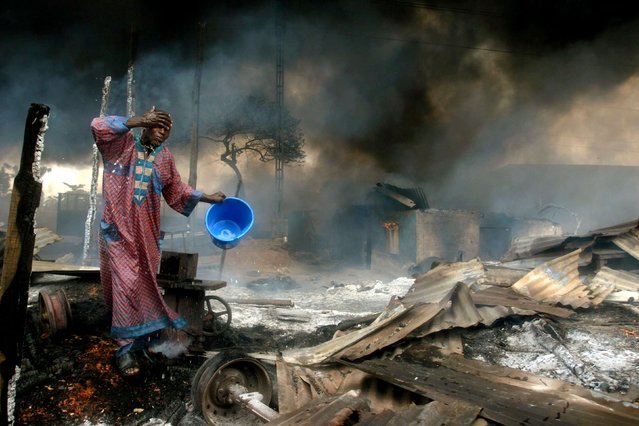
A man rinses soot from his face at the scene of a gas pipeline explosion near Nigeria's commercial capital Lagos in this December 26, 2006 file photo. Up to 500 people were burned alive when fuel from a vandalised pipeline exploded in Nigeria's largest city. Hundreds of residents of the Abule Egba district went to scoop fuel using plastic containers after thieves punctured the underground pipeline overnight to siphon fuel into a road tanker, locals said. (Photo by Akintunde Akinleye/Reuters)
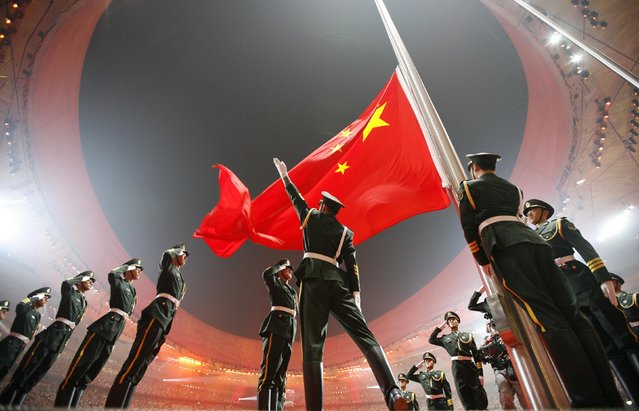
China's national flag is raised during the opening ceremony of the Beijing 2008 Olympic Games at the National Stadium in this August 8, 2008 file photo. (Photo by Jerry Lampen/Reuters)
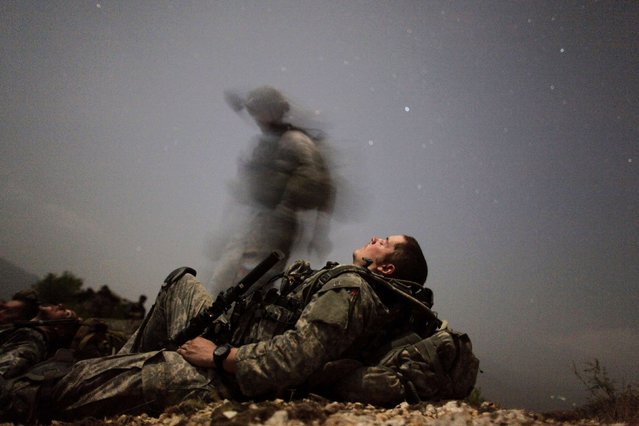
A U.S. soldier of 2-12 Infantry 4BCT-4ID Task Force Mountain Warrior takes a break during a night mission near Honaker Miracle camp at the Pesh valley of Kunar Province in this August 12, 2009 file photo. (Photo by Carlos Barria/Reuters)
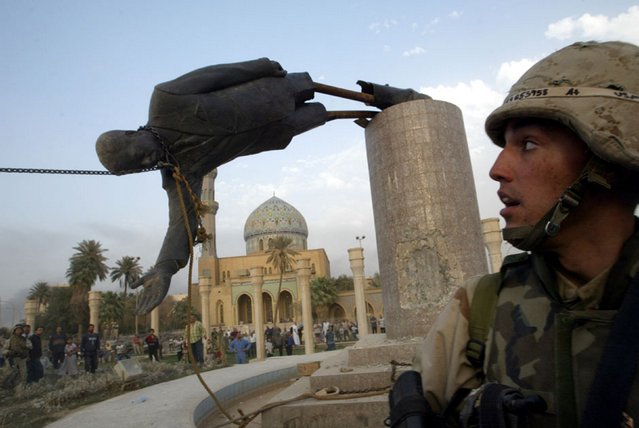
U.S. Marine Corp Assaultman Kirk Dalrymple watches as a statue of Iraq's President Saddam Hussein falls in central Baghdad in this April 9, 2003 file photo. U.S. troops pulled down a 20-foot (six-metre) high statue of President Saddam Hussein in central Baghdad and Iraqis danced on it in contempt for the man who ruled them with an iron grip for 24 years. In scenes reminiscent of the fall of the Berlin Wall in 1989, Iraqis earlier took a sledgehammer to the marble plinth under the statue of Saddam. (Photo by Goran Tomasevic/Reuters)
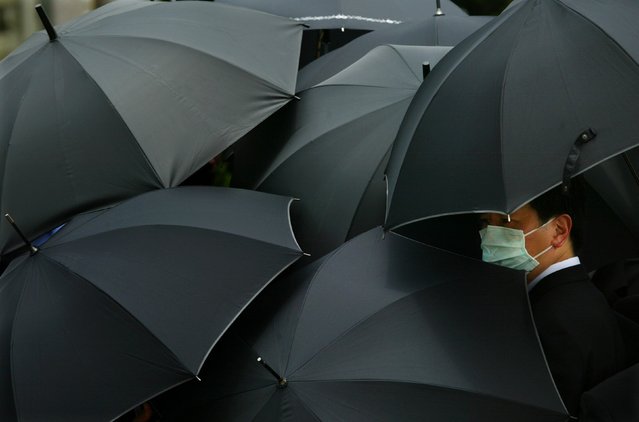
A mourner wearing a mask to ward off SARS hides under an umbrella during the funeral of SARS doctor Tse Yuen-man in Hong Kong in this May 22, 2003 file photo. Between November 2002 and July 2003, an outbreak of SARS in southern China caused 774 deaths in multiple countries with the majority of cases in Hong Kong according to the World Health Organization (WHO). (Photo by Bobby Yip/Reuters)
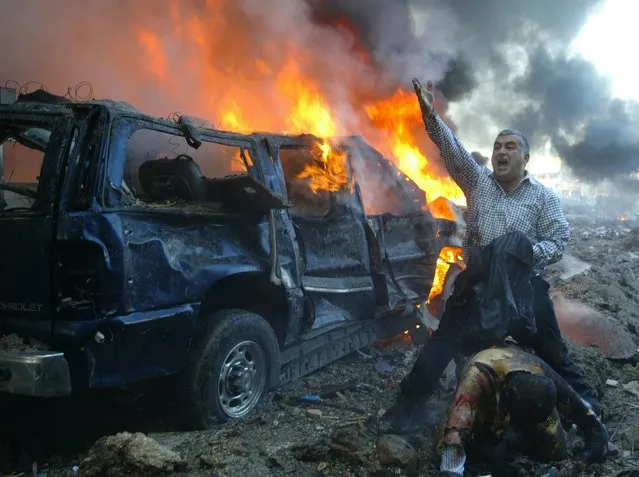
A Lebanese man shouts for help for a wounded man near the site of a car bomb explosion in Beirut, February 14, 2005. A massive car bomb killed Lebanon's former Prime Minister Rafik al-Hariri on Beirut's waterfront, witnesses and security sources said. At least eight others, some of them his bodyguards, also died. (Photo by Mohamed Azakir/Reuters)

Protestors hold signs behind Richard Fuld, Chairman and Chief Executive of Lehman Brothers Holdings, as he takes his seat to testify at a House Oversight and Government Reform Committee hearing on the causes and effects of the Lehman Brothers bankruptcy, on Capitol Hill in Washington in this October 6, 2008 file photo. Fuld told Congress that U.S. banking regulators knew exactly how Lehman was pricing its distressed assets and about its liquidity in the months before its collapse. (Photo by Jonathan Erns/Reuters)
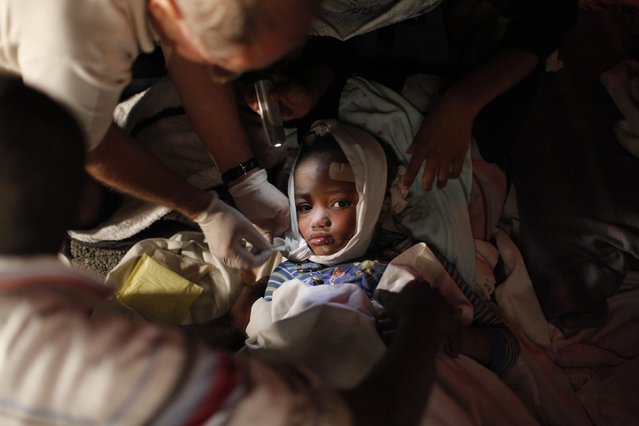
An injured child receives medical treatment after an earthquake in Port-au-Prince in this January 13, 2010 file photo. The 7.0 magnitude quake rocked Haiti, killing thousands of people as it toppled the presidential palace and hillside shanties alike and leaving the poor Caribbean nation appealing for international help. (Photo by Eduardo Munoz/Reuters)
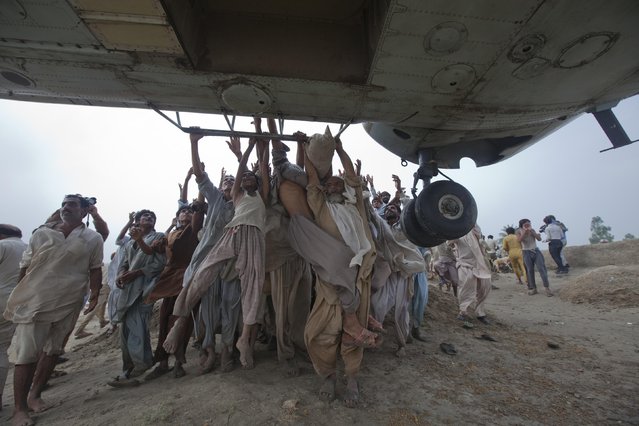
Marooned flood victims try to grab onto the side bars of a hovering army helicopter which arrived to distribute food supplies in the Muzaffargarh district of Pakistan's Punjab province in this August 7, 2010 file photo. Pakistanis desperate to get out of flooded villages threw themselves at helicopters as more heavy rain was expected to intensify both suffering and anger with the government. The disaster killed more than 1,600 people and disrupted the lives of 12 million. (Photo by Adrees Latif/Reuters)
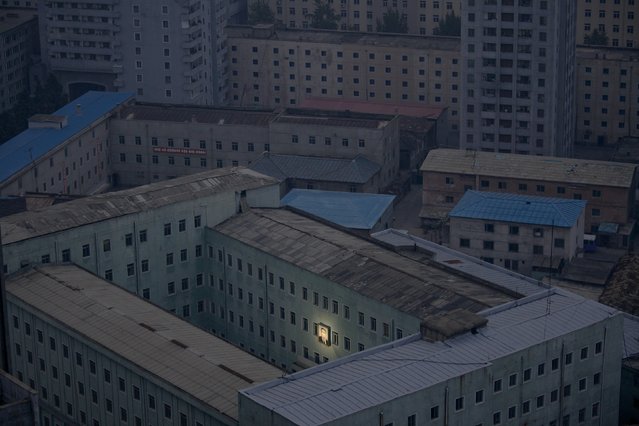
A picture of North Korea's founder Kim Il-sung decorates a building in the capital Pyongyang early in this October 5, 2011 file photo. (Photo by Damir Sagolj/Reuters)
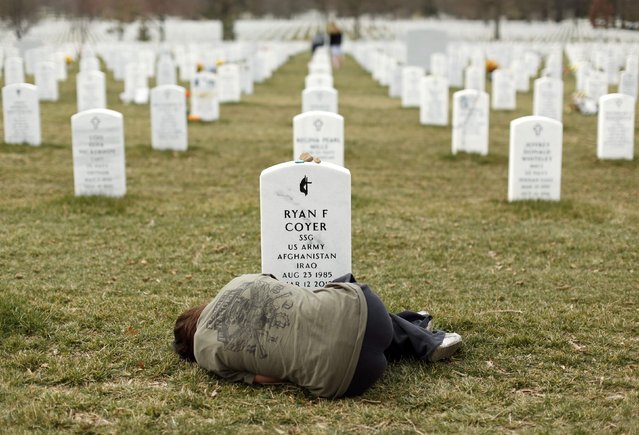
Lesleigh Coyer, 25, of Saginaw, Michigan, lies down in front of the grave of her brother, Ryan Coyer, who served with the U.S. Army in both Iraq and Afghanistan, at Arlington National Cemetery in Virginia in this March 11, 2013 file photo. Coyer died of complications from an injury sustained in Afghanistan. (Photo by Kevin Lamarque/Reuters)
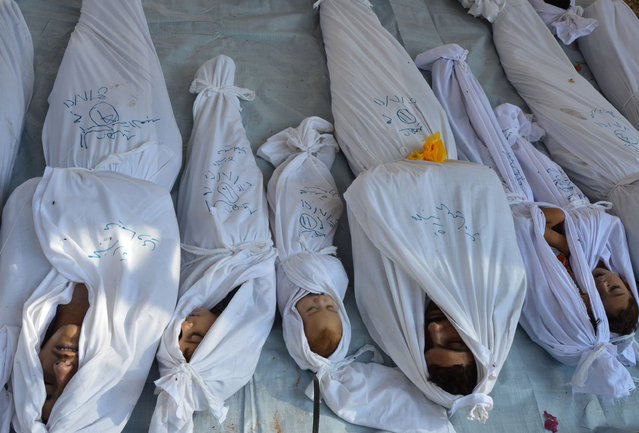
Bodies of people activists say were killed by nerve gas in the Ghouta region are seen in the Duma neighborhood of Damascus, Syria, August 21, 2013. Syrian activists said at least 213 people, including women and children, were killed in a nerve gas attack by President Bashar al-Assad's forces on rebel-held districts of the Ghouta region, east of Damascus. (Photo by Bassam Khabieh/Reuters)
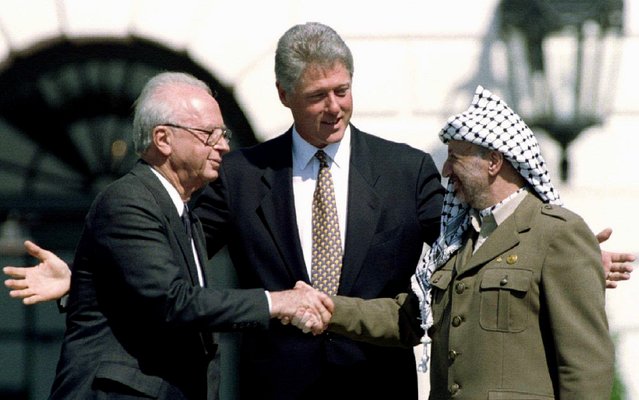
U.S. President Bill Clinton (C) looks on as Israeli Prime Minister Yitzhak Rabin (L) and Palestine Liberation Organization (PLO) leader Yasser Arafat shake hands after the signing of the Israeli-PLO peace accord at the White House in this September 13, 1993 file photo. (Photo by Gary Hershorn/Reuters)
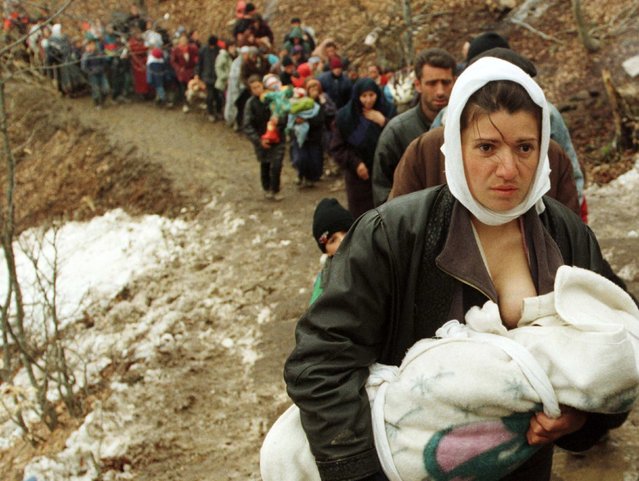
An ethnic Albanian woman feeds her baby as she and another 2,000 refugees, displaced by the war in Kosovo, are allowed to enter Macedonia in the mountainous region near the border crossing of Blace in this March 30, 1999 file photo. More than 2,000 Kosovo refugees entered Macedonia after crossing the mountains in south Kosovo overnight. The refugees were blocked by the Macedonian army for several hours and spent the night in the forest, but were later allowed to enter Macedonia after UNHCR officials put pressure on the Macedonian government. (Photo by Damir Sagolj/Reuters)
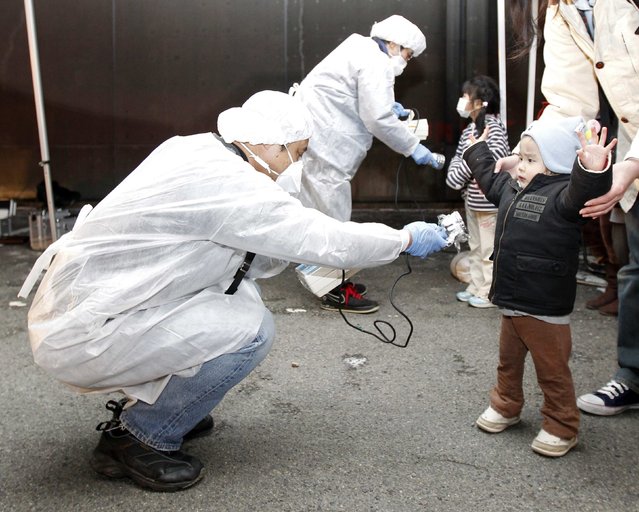
Officials in protective gear check for signs of radiation on children who are from the evacuation area near the Fukushima Daini nuclear plant in Koriyama in this March 13, 2011 file photo. The biggest earthquake to hit Japan on record struck the northeast coast, triggering a 10-metre tsunami that swept away everything in its path, including houses, ships, cars and farm buildings on fire and caused the meltdown of the Fukushima nuclear power plant. (Photo by Kim Kyung-Hoon/Reuters)
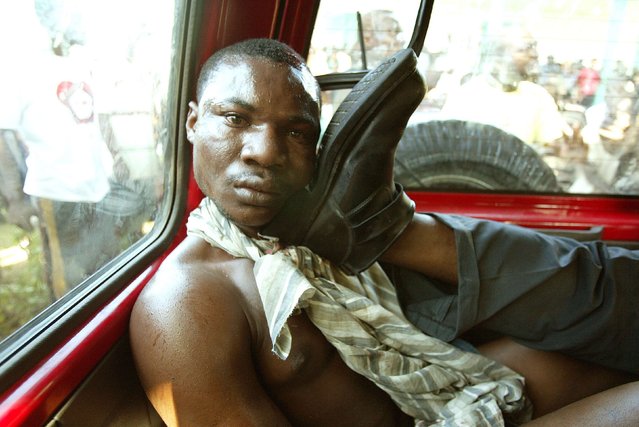
A Haitian suspected of being a multiple assassin for exiled president Jean Bertrand Aristide's Lavalas party is detained in Petit Goave, in this March 3, 2004 file photo. The man was detained by armed citizens of Petit Goave who proceeded to stone him and then burn him alive. (Photo by Daniel Aguilar/Reuters)
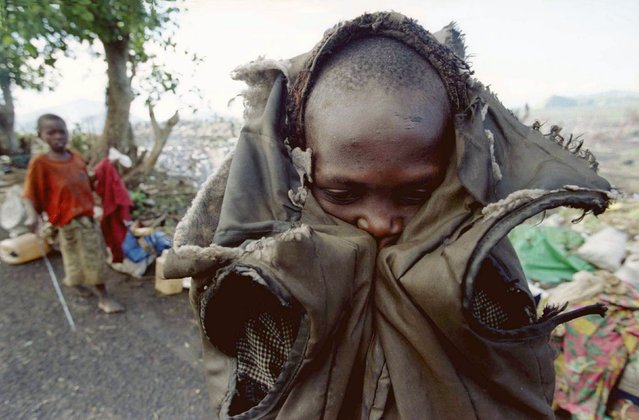
A young Rwandan refugee who travelled from Bukavu with several thousand others shivers in the early morning in this November 30, 1996 file photo before getting back on the road to the border. He was part of a group of some 20,000 refugees, many suffering from disease and malnutrition, who had made their way into Goma after being on the road for over one month. (Photo by Corinne Dufka/Reuters)
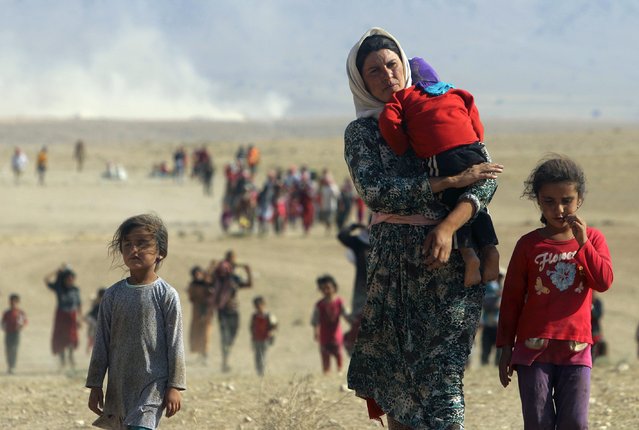
Displaced people from the minority Yazidi sect, fleeing violence from forces loyal to the Islamic State in Sinjar town, walk towards the Syrian border on the outskirts of Sinjar mountain near the Syrian border town of Elierbeh of Al-Hasakah Governorate in this August 11, 2014 file photo. The Islamic State, which had declared a caliphate in parts of Iraq and Syria, prompted tens of thousands of Yazidis and Christians to flee for their lives during their push to within a 30-minute drive of the Kurdish regional capital Arbil. (Photo by Rodi Said/Reuters)
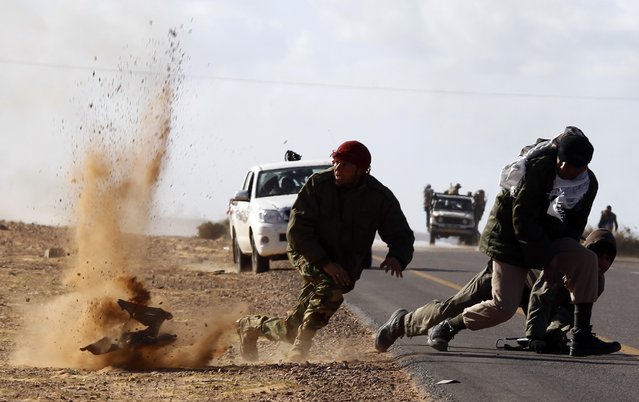
Rebel fighters jump away from shrapnel during heavy shelling by forces loyal to Libyan leader Muammar Gaddafi near Bin Jawad in this March 6, 2011 file photo. Rebels in east Libya had regrouped and advanced on Bin Jawad after forces loyal to Muammar Gaddafi ambushed rebel fighters and ejected them from the town earlier in the day. (Photo by Goran Tomasevic/Reuters)
15 Feb 2015 13:43:00,
post received
0 comments
